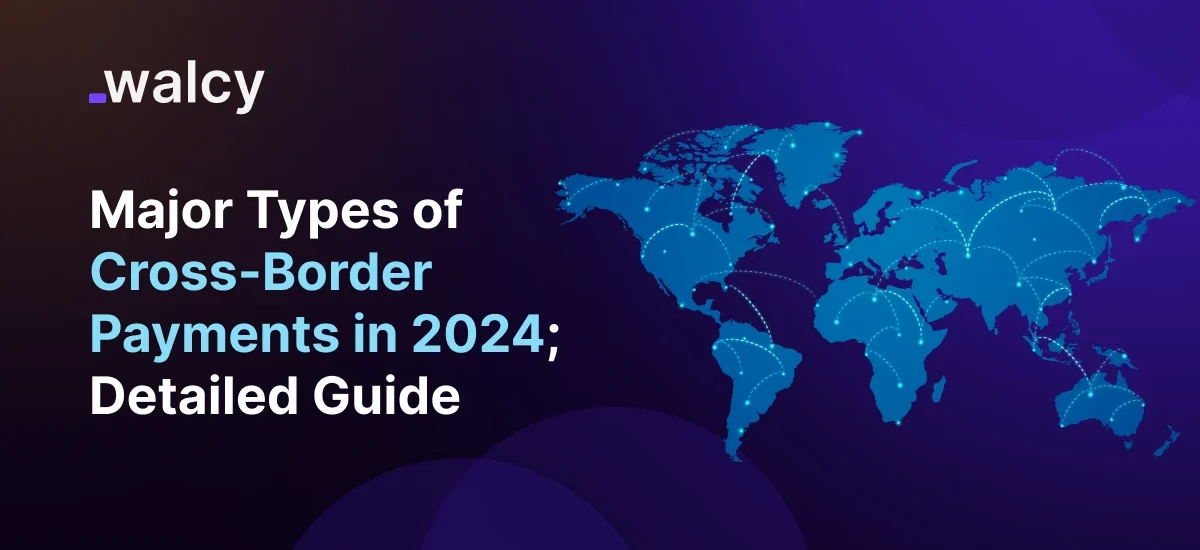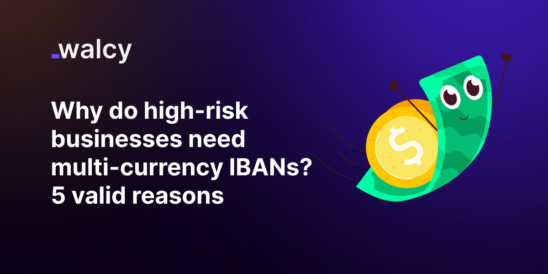Cross-border payments are key facilitators of cash movement between and amongst nations in the global economy. They take shapes and forms, whether over who transacts, the transaction’s nature, or the systems involved.
In this blog, we will look at major types of cross-border payments, who uses them, and their applications in different sectors of the economy.
Major Types of Cross-Border Payments
Wholesale Cross-Border Payments
Wholesale cross-border payments are high-value transfers between financial institutions, large corporations, and governments that take place internationally.
These payments are the backbone of global financial markets; they help realize huge trades, investments, and capital flows.
Unlike retail payments, which usually have small value and are largely simple, wholesale transactions involve huge amounts and frequently need considerable compliance and regulatory oversight.
These transactions are vital for foreign exchange settlements, various international securities settlements, and bulk interbank clearing.
In many of these voluminous and crucial transactions, there are lots of compliance-related issues that need to be sorted out, like AML/CTF requirements, which increase the time of processing.
Hence, wholesale cross-border payments take normally 1 to 3 days to complete; however, times have started reducing with increased technology.
Who uses them:
Central banks, commercial banks, large enterprises, and financial institutions conducting high-value cross-border deals.
Examples:
Include foreign exchange transactions, international securities settlements, and large interbank transfers that underpin major financial operations.
Transaction speed:
Normally slower, as due diligence and observance of regulatory requirements have to be complete; generally takes from 1 to 3 days.
Read about: GST For Foreign Exchange Transaction? Must Know Things.
Retail Cross-Border Payments
Retail cross-border payments are those transactions that are of a lower value and thus take place between individuals and businesses. These can be considered for consumer purchases, personal remittances, or freelance payments.
As such, these retail cross-border payments also play a significant part in enabling e-commerce worldwide, as consumers increasingly purchase goods and services from sellers around the world.
They also enable individuals to transfer money to their family members or pay for various services across borders, linking them with the remittance industry.
Digital payment platforms and mobile wallets make cross-border retail payments much more feasible and smoother. While modern solutions in the field of payments can already offer real-time transaction execution, traditional banking methods can take up to 1 or even 2 days.
The gig economy platforms and e-commerce are increasingly dependent on such kinds of payment varieties for freelancer compensation, international sales processing, and customer cross-border payment handling.
Who uses them:
Individuals, small businesses, e-commerce websites, and gig economy workers.
Examples:
Online shopping payments, international freelance payments, remittances.
Transaction Speed:
Instant with digital payment solutions; mostly 1-2 days with the conventional method.
Cross-border Interbank Payments
Cross-border interbank payments are payments between banks for international trade, loans, or large corporate transactions to be cleared and settled.
They bear immense relevance to world finance because they enable different banks to move funds across borders on behalf of either their clients or related to banks’ financial operations.
Interbank payments play a very important role in the maintenance of international market liquidity; they not only further currency exchange but also huge corporate deals that end with the merger and acquisition of companies.
The cycle may involve many middlemen, sometimes involving correspondent banks that make the whole transaction circuitous and delay the time of settlement of the payments.
Complying with international regulatory frameworks, such as AML regulation requirements, is also a factor to reckon with in the process.
Despite these challenges, modern systems are bridging the gap in the efficiency of interbank cross-border payments, with real-time settlement already applied by certain networks to fasten their clearing process.
Who uses them:
Banks, large financial entities, and multinational corporations.
Examples:
Interbank foreign exchange transfers, international trade financing, and loan settlements.
Transaction speed:
Generally takes 1-3 days, depending on the banking systems and regulatory checks involved.
P2P Cross-Border Payments
In cross-border P2P, money is sent directly by an individual to another without the use of any conventional middleman, like a bank. These types of transfers are also very popular among migrant workers or anyone sending remittances back to family members in other countries due to greater efficiency and comparative cost savings compared to using a bank.
P2P payments have become prominent, enabled through digital applications and platforms that make transferring money across borders more available and affordable.
Sending money to friends across town, to support a small business for a personal service or product, is simply a matter of a couple of clicks using mobile applications or other online means. The length of time it takes to process such a transaction depends on the means of conducting the transaction: newer digital payment platforms can transfer money in virtually real-time, and traditional bank transfers can take several days.
Who uses them:
Migrant workers support family, friends, or personal businesses.
Examples:
Includes sending money back home and making transfers to friends or relatives living abroad.
Transaction Speed:
With the advent of modern mobile phone applications, the time taken for a transaction is instant. It used to take several days earlier on with other traditional approaches.
Cross-Border B2B Payments
Cross-border B2B payments are transactions that occur between businesses in different countries. These are often for the exchange of goods, services, or the fulfillment of a contract.
They are among the most critical components of international trade and global supply chains for companies to meet their liabilities arising due to foreign supplies, partners, or service providers.
As the world moves with globalization, B2B payments have increased in importance, underpinning everything from manufacturing and logistics through digital services and professional collaborations.
International trade, though, tends to involve higher-value B2B payments that may be denominated in multiple currencies. Companies need nimble, reliable ways to transmit and receive payments lest their supply lines falter.
Not all the different means of paying are equally as fast; for example, while same-day transfers are common with modern digital solutions and specific B2B platforms, other means are reliant on the traditional banking timeline of 2-3 days for clearance.
Who uses them:
Importers, exporters, multinational companies, suppliers, and service providers.
Examples:
Settlements for goods and services; international business contracts; supply chain settlements.
Speed of Transaction:
Instantaneous with the newest digital solutions; 2-3 days using older means.
Cross-Border Business-to-Consumer Payments
Such cross-border B2C payments are made by businesses to individuals in other countries, possibly through online purchases via an e-commerce site, gig economy platforms, or online service providers. Besides such purchase refunds, these payments might include salary disbursements, freelancing remittances, commissions, or even rewards and incentives.
B2C payments are an area of growing importance to companies that have plans for compensating international workers or refunding global customers with the growth in global digital marketplaces and a gig economy.
Speed and reliability are foremost in B2C payments, whereby consumers demand that their transactions be faster and without trouble. In such modern digital payment platforms, these transfers were made possible within several minutes or one day depending on the solution employed by the business.
Besides this, businesspeople also have to figure out different tax laws, rules of compliance, and currency conversion to ensure cross-border transactions go through without any glitches.
Who uses them:
E-commerce companies, online service platforms, and gig economy companies.
Examples:
E-commerce refunds, freelancer payouts, royalty/commission payouts.
Speed of the transaction:
Usually fast, from several minutes up to one day.
Government Cross-Border Payments
Government cross-border payments represent large-scale transactions performed by governments for international obligations, funding diplomatic missions, giving foreign aid, or for development projects abroad.
They are very critical to the sustenance of international relations, the fulfillment of contractual obligations existing between nations and entities from other countries, and the financial coverage of global initiatives, such as humanitarian assistance and development undertakings.
Given the scale and sensitivity of these payments, they often involve rigorous oversight and are subject to complex compliance and regulatory frameworks.
Payments across borders by the government take several days and even weeks because such transactions require rigorous checks, which include AML and compliance with sanctions. This may be compounded further by the number of government agencies and international organizations concerned in such transactions.
Who Uses Them:
Governments, foreign contractors, international organizations, and development agencies.
Examples:
Foreign aid transfers, payment for diplomatic missions, government services, and international development projects.
Transaction Speed:
Generally slow, taking several days to weeks due to very strict regulatory and compliance demands.
Read more: All About Overseas Payments (2024); Comprehensive Guide
Cross-Border Settlements in Cryptocurrencies
Cryptocurrencies use blockchain technology to allow for the immediate, decentralized transfer of value from one party to another across borders. It’s a substitute for slow and expensive traditional banking. Crypto payments sound very attractive to tech-savvy users, freelancers, international investors, and other people who would like to see speedier, inexpensive, or anonymous transactions.
Many cryptocurrencies eliminate the need for third-party intermediaries and sometimes even traditional finance altogether, allowing for drastically lower transaction fees and times.
The usage of cryptocurrencies like Bitcoin, Ethereum, or stablecoins is especially useful in highly restrictive banking environments or where the expenses of transactions are too high. They represent new ways in which value can be transferred both quickly and securely, oftentimes with transaction times of under one hour. Users should consider the volatility and possible regulatory issues that come along with digital currency.
Who uses them:
Technology companies, freelancers, international investors, and those looking to execute fast or anonymous transactions.
Examples:
Cross-border transfers, especially in an environment where banking fees are relatively high or are supported by highly restrictive policies regarding banking.
Transaction speed:
Usually happens within minutes, which highly depends on the network congestion level.
Read about: Cross-Border Payment Solutions: Past vs. Present vs. Future
Conclusion
Cross-border payments are essential in maintaining the stability and efficiency of financial markets worldwide. These provide the possibility of high-value transactions that sustain international trade and investment.
Because they are always large-value and complex, these payments have always taken several days due to extended compliance checks. However, better technologies and real-time settlement systems will eventually make these transactions speedier and more efficient.
Wholesale cross-border payments will continue to play an increasingly vital role in international commerce as global transactions grow unabated. It will be necessary to learn about a variety of key players and systems, such as SWIFT, RTGS, and Fedwire, to navigate these intricacies in international finance and ensure the security and punctuality of transactions.



